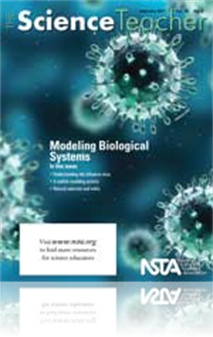All Resources
Journal Article
Science Sampler: Clever with weather
In eighth-grade Earth science at Louisville Middle School in Louisville, Colorado, students learn how large-scale weather patterns such as the jet stream and weather fronts interact to generate local weather conditions. The authors have developed a m...
Journal Article
Science Sampler: Fun with a flume—Ideas for inquiry
A flume is a channel that is constructed to divert a flow of water for a specific purpose. Many students recognize the term flume from experience with an amusement park ride called the “log flume.” For the inquiry-based activities described here,...
Journal Article
Teaching Through Trade Books: Disease Detectives
“You’ve got cooties!” is a traditional taunt between children on the playground. Although children’s avoidance of “boy or girl” germs is not scientifically based, students have an innate understanding that transmission of germs can happen...
Journal Article
An Earth-system Approach to Understanding the Deepwater Horizon Oil Spill
The Deepwater Horizon explosion on April 20, 2010, and the subsequent release of oil into the Gulf of Mexico created an ecological disaster of immense proportions. The estimates of the amounts of oil, whether for the amount released per day or the to...
Journal Article
Safer Science: Equipment Safety—UL Ratings and More
The UL label signifies that an appliance has been safety-tested in accordance with a specific set of standards. This ensures safer operation and built-in protection for the user. Science teachers might find themselves asking whether the same is true ...
Journal Article
Guest Editorial: When teachers become scientists
Ask yourself this question: Have you ever worked on a real scientific experiment? Your thoughts may jump to the lab components of your undergraduate science courses and the research papers/assignments you completed in college, but should such structu...
Journal Article
Ocean Acidification: Hands-On Experiments to Explore the Causes and Consequences
Ocean acidification is one of the most serious environmental issues facing the planet (e.g., Doney 2006; Guinotte and Fabry 2009). It is caused by excess carbon dioxide (CO2) in the atmosphere. Human activities such as burning fossil fuels put CO2 an...
Journal Article
Idea Bank: Electronic BeeSpace
Recent press coverage of the decrease in worldwide honeybee population (Kaplan 2010) has significantly increased public awareness of its ecological and economic importance. In addition, honeybees’ social nature, novel method of gender determination...
Journal Article
Editor’s Note: Selecting Inquiry Investigations
The National Science Education Standards (NSES) specifically addresses the frequency with which teachers should incorporate inquiry as a strategy in their science classrooms. “Although the Standards emphasize inquiry, this should not be interpreted...
Journal Article
Science 101: What causes convection?
Convection is when different parts of a fluid move in a more-or-less circular path, with parts of the fluid at the bottom moving to the top and vice versa. Here fluids refer to both liquids and gases. Convection happens when you have two fluids toget...





